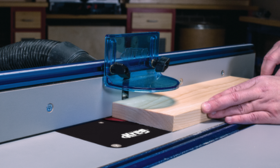A router table is a great addition to any woodworker's tool collection. It enables you to work on larger pieces of wood while also providing greater control and precision over your cuts. Router tables are classified into three types: benchtop, free-standing and cabinet style. With the right table, you can advance your routing skills and achieve profession-looking results on all of your woodworking projects.
A router table is essentially a table that houses your router, allowing you to work on larger pieces of wood with greater control and precision. The table comes with a fence to act as a guide for your router and plate to adjust the height of the router bit.
A router table is commonly used for creating decorative edges, cutting dados and grooves, making raised panels, and crafting precise joinery like dovetails and box joints. With the workpiece guided along the fence rather than maneuvering the router by hand, a router table enhances accuracy and consistency, especially for repeated cuts.
Check out our article: The Top 5 Things You Can Do With a Router Table
A router table is made up of a table, a fence, a plate, and a miter gauge. the table provides a stable work surface for your router, while the fence guides your workpiece and provides stability as you work. The plate secures the router and allows you to adjust the height of the router bit. The miter gauge is the component used to make precise angled cuts.
Router tables are classified into three types: benchtop, free-standing, and cabinet style. The most common type is free-standing router tables. They are typically larger than benchtop tables and more stable and durable. Benchtop router tables are the smallest and most portable option. When not in use, they are typically small enough to fit on a workbench and are easy to store. Cabinet router tables are the most robust option - they are large and stable, with a cabinet to store your router and accessories.
Check out our article: How to Choose a Router Table
Router tables are designed to fit the majority of routers, but be sure to check compatibility before your purchase. Some router tables are tailored to specific models or brands. First, check the plate size and the size of the opening in the table, then check the compatibility of the router base plate with the router table plate. For years, having a router table meant you needed a router to dedicate to it. While having ore tools is always good, having redundant tools isn't. These days, router manufacturers make it easier by offering routers in combo kits that come with a fixed base and a plunge base. That way, you can mount the fixed base to your router table and still have a super-functional plunge router. All you have to do is swap the router motor from one base to the other, which only take a few seconds.
Although using a router table is relatively simple, you must set it up correctly for the best results. After making sure the table is stable and level, set the router bit's height to the proper level. After that, clamp the workpiece to the table so that it is perpendicular to the fence. Then, turn on the router and begin your cut. Remember to wear the right safety gear, and make sure your hands are a safe distance from the router bit.
There is no simple answer to this question because it is dependent on the task at hand. When working with larger pieces of wood, a router table gives you more control and precision over your cuts. It also makes it easier to perform more complex cuts, such as edge profiling and mortising. A router, on the other hand, is more versatile and portable, making it ideal for smaller projects or working on the go. This is where router combo kits - combo kits that come with a fixed base and a plunge base - come into play, giving you the most versatility in how you want to work.
The value of a router table is determined by your needs as a woodworker. If you frequently work on larger pieces of wood or want to expand your routing capabilities, a router table is a worthwhile investment. They're also great for quickly and easily making repetitive cuts, such as edge profiling.














